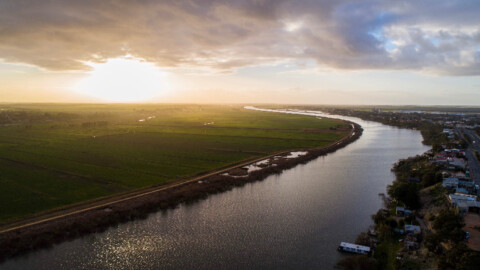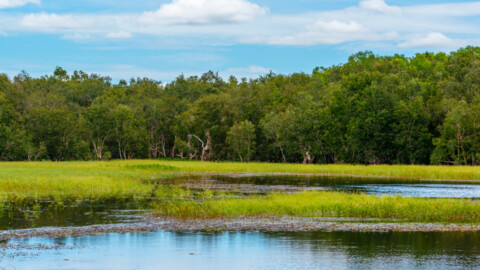Climate change, bushfires and extreme heat have forced many bat colonies to relocate to avoid exposure to fatally high temperatures. One innovative way to alleviate heat stress among these threatened animals is by implementing large sprinkler systems, which effectively operate as a large evaporative cooler, to mitigate the effects of heat during summer. Parks Victoria has utilised this method, installing an electric pump and generator in an internationally applauded sprinkler system designed to protect Yarra Bend Park’s grey-headed flying-fox colony.
During summer heatwaves and bushfires, these native bats have been devastated with both habitat loss and loss of life. Thousands of grey-headed flying-foxes – which are a protected species – die of heat exhaustion each summer, with climate change exacerbating the length and intensity of the season.
Yarra Bend Park, home to Victoria’s largest permanent colony of greyheaded flying-foxes, was especially impacted – over a three-day period in 2020, temperatures reached 43ºC and caused the death of more than 5,000 bats at the park.
But a new permanent sprinkler system, powered by an electric pump and generator, will protect the colony of approximately 30,000 bats at Yarra Bend Park, functioning as a giant evaporative cooler for the area.
Parks Victoria Area Chief Ranger, Brendan Sullivan, said the aim of the project is to protect and enhance grey-headed flying-fox habitat and conservation. “The grey-headed flying-fox is a threatened species listed under the Commonwealth Environment Protection and Biodiversity Conservation Act 1999 and Victoria’s Flora and Fauna Guarantee Act 1988.
Their numbers have declined due to loss of prime feeding habitat and disruptions to their campsites. They are also threatened by climate change, with increased heat-stress mortality in hotter-than-average summers,” Mr Sullivan said. Grey-headed flying-foxes are subject to heat stress mortality when temperatures exceed 40ºC, and Yarra Bend Park experiences heat stress events most summers.
“During these events, volunteers are traditionally mobilised to prevent greyheaded flying-fox deaths by spraying them with water from a 20L backpack sprayer and taking them into care for rehydration. “These events require substantial planning and present significant safety risks to volunteers and staff,” Mr Sullivan said.
Designing an internationally applauded, permanent sprinkler system
The custom-built, $180,000 sprinkler system was funded by the Department of Energy, Environment and Climate Action (DEECA), and delivered by Parks Victoria in partnership with Zoos Victoria, who led the design of the system. Additional partners included Melbourne Water, Yarra Bend Golf, Wildlife Victoria and passionate volunteers.
This internationally recognised initiative forms part of a $5.3 million boost for wildlife from the Victorian Budget 2022/23. Following a series of similar sprinkler system trials at the Warrnambool, Bendigo and Colac botanical gardens, the Yarra Bend Park sprinkler system is the first to be installed as a permanent fixture.
Mr Sullivan said the sprinkler system has been fully installed and commissioned as of January 2023, with the completion date extended from the expected November 2022 as a result of October 2022 storms that led to flooding of the Yarra River, making access to complete the pump installation impossible.
The system is made up of aerial sprinklers that are placed in the trees and are turned on for a few minutes each hour to rain down on the bats. Thirtytwo sprinkler heads have been installed across two sites identified as important refuges for the flying foxes.
“The main objective of the new, Victorian Government-funded sprinkler system is to prevent bats going into heat stress/heat stroke by cooling the ambient temperature using water. The system acts like a massive evaporative cooler,” Mr Sullivan said.
The sprinklers are activated on days when the colony is likely to experience heat-induced illness. This is determined by both behavioural monitoring and when temperatures rise above 38ºC.
The system works to rapidly cool the environment by five to six degrees on days of extreme heat. Since the installation of the system, the colony of approximately 30,000 have enjoyed these major temperature drops throughout February, especially on days where the mercury reached 41ºC.
“We also wanted to use off-the-shelf materials and not create a completely bespoke system that requires special orders for parts. This allows any repair to be undertaken quickly and keeps production costs down,” Mr Sullivan said. “The sprinkler mainline runs for more than 750m and reduces in diameter towards the end of the line to sustain appropriate pressure.
It starts off at 125mm and reduces incrementally down to 90mm. “Given terrain type, the mainline was winched through in sections and welded together on site.” Mr Sullivan said that after testing numerous sprinkler heads, the Rain Bird 8005 was selected based on coverage and customisation of the spray pattern.
“Thirty-two sprinkler heads on galvanised poles extended beyond the tree canopy make up the sprinkler component of the system and when all are operating provide coverage across 3ha.”

Sprinkler system trials
The system at Yarra Bend Park was bolstered by successful trials of similar systems at Warrnambool, Bendigo and Colac botanical gardens. At the Bendigo Botanic Gardens, where 200 bats died from heat stress in the summer of 2020, a temporary sprinkler system was able to lower the atmospheric temperature and reduce fatalities in 2021.
Data from the trial showed that temperatures in the test zone dropped by up to 2ºC, and no flying fox deaths were recorded. The trial ended in the summer of 2022.
The specifications of the system
Mr Sullivan said that the Yarra Bend system had unique specifications. “The system will challenge even the most experienced engineer; water must be drawn from the Yarra into the colony and the system needs to reach the eucalypt canopy eleven metres up, covering three hectares.” Bats are extremely sensitive to noise, and excessive noise can potentially disturb bats and discourage them from roosting in the area.
The sprinkler system’s electric pump and generator allow for minimum noise and disturbance to the animals, compared to a diesel motor, a quality Mr Sullivan said was a key factor when it came to selecting which pump to use.
“Previous trial pumps were petrol and produced noise at about 89db which caused disturbance to the bats. Given there were up to five of these pumps spread out across the colony the impact was deemed to be significant. “The electric pump is silent and the 75kW diesel generator that powers the pump runs at about 55db and is away from the main colony.”
Additionally, Mr Sullivan said it was important that operators were given the ability to close off sprinklers if bats were not in the area, as well as having the option to operate a reduced number where appropriate.
“The only way we could achieve this was by installing a variable drive pump that maintains a constant pressure of 600Kpa even if all sprinkler heads are off. “The use of a non-variable drive pump would see maximum pressure not being maintained at 600Kpa likely resulting in blown joins and valves.”
System installation
The design and installation of the system was not without its complications. “There were two main challenges in designing the system.
Soil disturbance – which wasn’t permitted due to cultural sensitivity – and no power on site,” Mr Sullivan said. “Given the length of the mainline we also had to decide whether multiple pumps made up the system, or just one large pump.
In the end we made the decision to go with a large pump floated in the river, powered by a diesel generator. “The mainline and valve infrastructure was all left above ground to assist with leak detection and maintenance.”

The next step
Mr Sullivan said that automating the system is the plan for the next 18 months. “We’ll be gathering data on temperature reduction when the sprinkler system is used and develop optimum on and off times to maintain a suitable temperature differential.”
With no end to climate change in sight, Mr Sulliavan hopes that the Yarra Bend Park system will serve as an example of positive human intervention for these threatened animals, and something other locations can utilise. “There has been a lot of good work and collaboration between everyone working with the same goal: to look after the grey-headed flying-foxes.
We’ve caused so much damage to these bats, it’s great to be able to do something that’s going to be of benefit for them. “This is going to be a game changer for this colony and for our management,” Mr Sullivan said.


















